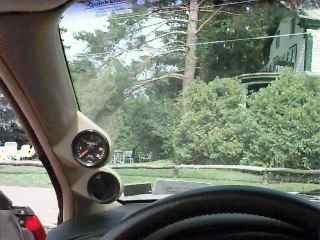Boost Gauge.
What does it do:
Well pretty simply a boost gauge displays the pressure in psi or bar (kg/cm2) at the intake manifold. Some read absolute pressure (relative to a perfect vacuum) and others read gauge pressure (relative to ambient atmospheric pressure). There are tons of arguments on which is the better to use to monitor your charge air system. The reality of the situation is that in this authors opinion the arguments just don't matter. The differences touted by both sides of the argument are minor enough, other variables extensive enough, and our tuning rough enough that it just doesn't matter. More so most boost gauges (all mechanical I know of and most electronic) all operate off gauge pressure anyway.
There is a very good reason to need to know the boost
level going into your motor. Most importantly if you try to run too much
boost into the motor for a given fuel octane and given compression ratio you
will at best suffer from bad timing and at worst damage your motor. The
details of all this will eventually be discussed in a section dedicated to
engine management and tuning, but for now you just need to know that too much
boost is bad and too little it slow. Having a gauge allows you to set and
then monitor the boost level. Monitoring is needed, rather than a set and
forget method, because shit happens, and as you start to push the car closer to
the edge and negate/reduce the effectiveness of stock fail safes you have to
keep a closer eye on the operation of your engine.The result of over boosting will be detonation and eventually catastrophic damage.![]()
Why Upgrade:
The stock "boost gauge" does not actually measure pressure. The ECU "calculates" the boost based on information it gets from the Mass Airflow Sensor, temperature, barometric pressure, engine RPM, and some efficiency assumptions; remember PV=nRT from physics/chemistry? The problem with this is those assumptions are thrown out the window when you mod the car and the ECU's assumptions about volumetric efficiencies are rendered invalid. Furthermore the ECU is not programmed to understand flows above the stock levels. Finally the stock 2g gauge doesn't even have numbers on it. DUH!
Now you may be wondering, "Why do I need a better boost gauge before I do any other mods." I'm glad you asked. Even though you may not have any mods which alter your boost level you still want to get a good gauge know. Here's why:
When I was done with my first few mods (K&N FIPK, pre-95 BOV, and $10 Upper IC mod) I had no way to be sure I had really done anything to my car. I hadn't base-lined it at the track so I just had to hope that they were worth the money. Once I finally got a boost gauge I had no way to determine if my mods had changed the boost behavior of my engine (spool-up and max boost). As it happens I also now know that those mods DO increase boost and as I said above, you have to keep an eye on your boost if you are messing with it. So do yourself a favor, spend the money now so you will know the rest of your money was well spent. Then when you are ready to start over-boosting you will already have your gauge to protect you from those dangerous boost levels.
What to upgrade to:
An aftermarket boost gauge measures actual pressure in either psi or bar (kg/cm2) at the manifold. Choose the one that best suits your needs. There are two basic kinds: Boost and Boost/Vac gauges. I recommend the Boost/Vac gauge since vacuum variations can help indicate problems which might be hard to diagnose. You are also able to see the whole range of the turbo's behavior (spool up). Typical gauges read from 30mmHg to either 20, 25, or 30 psi. I recommend 25 psi at a minimum. Anything lower will just prove useless in the future; trust me I learned the hard way.
Now that you have the boost gauge you need a way to mount it. I went through a few different iterations and finally settled on what is in my opinion the absolute best option. Lo-Tek Engineering makes a complete replacement for the A-pillar. It is a very well constructed part that look like it came with the car. I even once had a guy ask me (after losing a race to me), "Hey is this some special racing production model? That gauge cluster looks stock." It comes in dual and triple gauge trim. I would recommend the triple if you think you are going for a good powered car. You will need the room for gauges eventually. Otherwise get the dual. As for what to do with the open slots, just deal with them for a little while. They don't look that bad and you could always get some $10 2" gauge from an auto store to just stick in there. No need to even hook it up. It also of course comes in gray to match that interior and matches it well at that.
